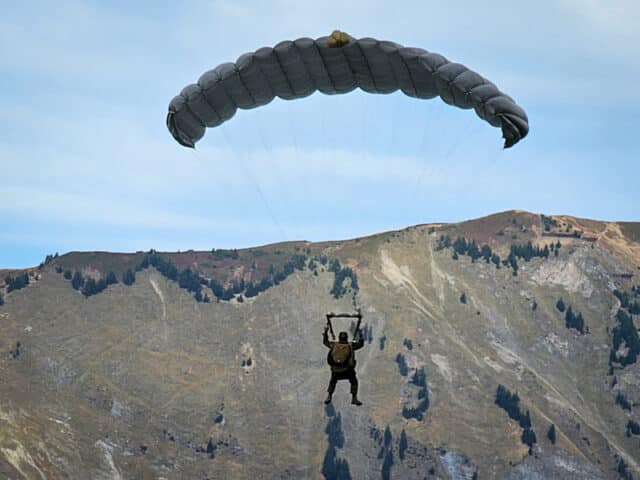The Swiss night sky was full of stars as I hiked up the mountain to the air show. It was a few degrees above zero and the lights of the village below looked dim and far away. Ahead, the...
The Swiss night sky was full of stars as I hiked up the mountain to the air show. It was a few degrees above zero and the lights of the village below looked dim and far away. Ahead, the black silhouette of a ridge against the dark blue night sky twinkled a long line of tiny headlamps marching up. We’d gathered in the early hours before dawn to ensure our seats at Axalp 2023, the Swiss Air Force’s live firing demonstration.
Axalp is a high alpine pasture on the northern slope of Axalphorn, overlooking Lake Brienz. The peak of Axalphorn looms over the Meiringen military airport. Located in a steep-sided Alpine valley at an elevation of 579 metres (1,900 feet), the airfield has a single concrete runway which runs parallel to the Aar River (10/28). Meiringen started operations at the end of 1941: as the Second World War progressed, it became clear that the army air force needed to be capable of defending the military and civilians if a retreat into the mountains became necessary. The Ebenflüh Shooting Range, west of Axalphorn, allowed the arms of the military to train together in the hostile terrain of the Alps, where close proximity to friendly forces would make for a unique fighting challenge.
Meiringen Air Base installed a command post (Kommandposten, now known as KP) at 2,244 metres (7,360 feet) above sea level, from which the military command could watch the results of the training. In 1950, Royal Air Force dignitaries were invited to see a demonstration of the Swiss Air Force skills and the annual exercise began to attract international attention. By the 1990s, the demonstration was expanded to a public airshow.
The Axalp Fliegerschiessen, which the Swiss Military are quick to explain is not an airshow but a live-fire training exercise to which the public is invited, is now a spectacular event. The roads in the area are sealed off; to watch the show, you must purchase tickets for the shuttle bus well in advance and then hike your way up to the top. Thousands of spectators come from around the world to watch the high-altitude display of military prowess, including, this year, me.
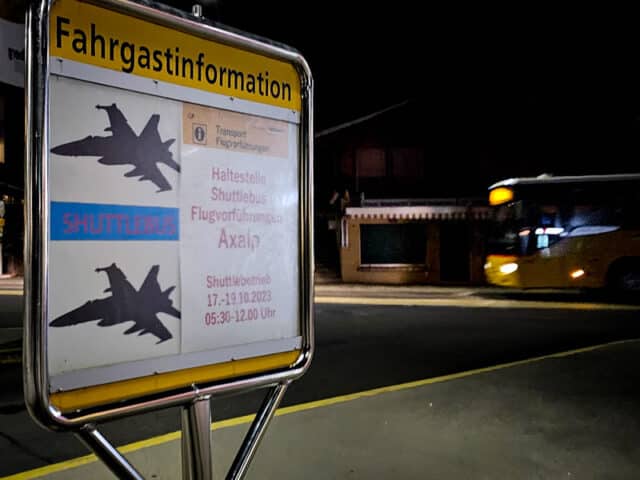
There are three official viewing areas, Brau, Tschingel and Ebenflüh KP. I had only glanced at the local maps, confident that I could find my way up by following all the other aviation enthusiasts. Transport was provided from Brienz train station to a car park just out of the city, where we were herded onto the constant stream of bus shuttles travelling up to Axalp. Even at 6:30 in the morning, the buses were full and travelling up the mountain in the dark just as quickly as they could get us loaded. We arrived at Axalp with plenty of time to hike up and find the best seats for the airshow starting at 14:00.
I have written about the hike up to Tschingel separately; suffice it to say that I was not, actually, as fit as I thought I was and I really should have spent more time understanding the terrain and trails available. Accompanied by a steady stream of helicopters flying the VIPs directly to KP, it was impossible to get lost. However, the route, especially via the chairlift, is extremely steep and difficult if you are a desk-bound armchair pilot like me. Combined with the thin air at high altitude, I was quietly losing the will to live when a fighter jet blasted through the valley in a practice run for the demonstration. Petrified that I was going to lose my balance and tumble down the mountain, I threw myself backwards to watch from a semi-prone position, gaping at the unexpected sight of aircraft flying past at eye level. One turned upside down just as it passed me.
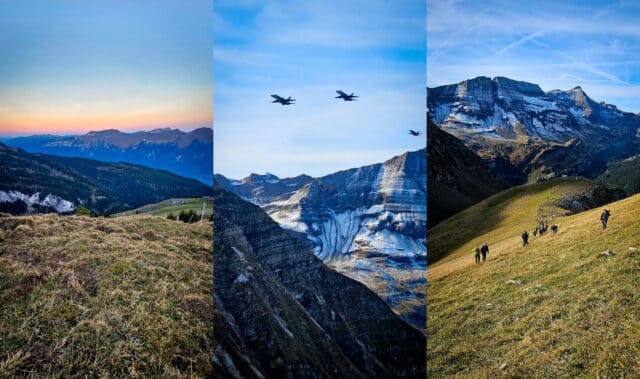
The 30-minute impromptu airshow revitalised me and I made it the rest of the way up the mountain, where the Super Pumas and Cougars had dropped large crates of food and equipment. A cluster of portable toilets and four-way urinals perched at the ridge overlooking Lake Brienz and a kiosk sold snacks and drinks (cold at ambient temperature!) for what seemed to me to be reasonable prices considering the effort that it took to get everything up there.
A loudspeaker system was spread across the three viewing areas and a friendly voice explained the background to the live-firing exercises in fluent German, French and English. He used landmarks to orientate us to north, south, east and west so that he could point us in the right direction to see the inbound aircraft. And then, at exactly 14:00, he told us to look north as a trio of McDonnell Douglas F/A-18 Hornets came roaring through the range.
I have been to a lot of air shows and I squeal like a little girl at all of them, I’m not going to lie. But the show at Ebenflüh Shooting Range was like nothing I have ever seen before. Partially, it’s the angle: usually at an airshow, I am craning my head up, trying to get the perfect view. Standing on the high alpine slope, I was looking directly at the aircraft speeding past me at 7,500 feet. The spectators shared a sense of camaraderie: we had all bought tickets that sold out within two weeks of going on sale, even for the training day, and had hiked up the mountain together. I have walked in the Alps before and even flown over them but this was an entirely different experience.
The F-18 Hornets started with a round of flares and then sped towards the base of KP, where they fired 22mm rounds at the fluorescent orange target.
After each pass, the man on the loudspeaker announced how well each one had scored. Today’s demonstrations were, he said, the same training that the Swiss Air Force used on all their pilots, with as little as possible modified for the benefit of the show.

The primary peacetime activity of the Swiss Air Force is air policing and we were given a quick primer on live missions (observation) and hot missions (intervention).
As we looked north again, a Pilatus PC-7 started the scenario: a typical small single-engine plane blundering into restricted Swiss airspace without talking to anyone. A Eurocopter AS332 Super Puma swiftly appeared and caught up to it, positioning itself in front and to the left of the small plane. I’m not sure how a helicopter waggles its wings but it didn’t make any difference. I can’t imagine how you could NOT see a ginormous helicopter suddenly appearing directly in front of you but our PC-7 pilot remained oblivious.
The Super Puma changed levels in hopes of attracting the pilot’s attention and then calmly but firmly fired a flare which dropped directly in front of the PC-7’s cockpit. That did the trick and the small plane waggled its wings to signal that it was now following. They circled around again so that we could watch the Super Puma show the PC-7 where the closest imaginary airfield was and demonstrate in which direction to land on our imaginary runway, which was presumably closed to imaginary traffic until the small plane had been dealt with.
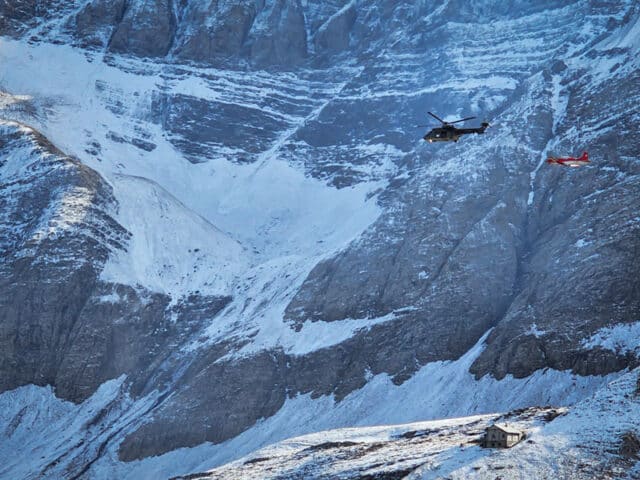
This was by far my favourite demonstration as I have always wondered what it must be like to be intercepted by the military, while desperately hoping that I will never have the practical experience of getting lost after dialling in the wrong frequency.
The PC-7 disappeared and a Cessna Citation Excel appeared in the distance. Loudspeaker-man explained that the scenario was the same; however, it might be a bit more difficult for the Super Puma to outfly the business jet. Three F-18 Hornets suddenly appeared out of nowhere, one positioning it to the front and left of the business jet while the other two flew alongside. If I was surprised that the Super Puma could outfly the PC-7, I was doubly surprised that the F-18s could slow down to the slow cruise of the Citation Excel.
At the risk of offending a fighter jet, I’m just going to say that F/A-18 Hornets do not look as friendly when waggling their wings as some other planes do. Again, our Citation Excel pilot kept flying, somehow unaware of the roaring Hornets swarming around the aircraft. The three fighter jets set off flares in sequence, lighting up the sky around the intruder like a Christmas tree. I imagined the hapless Citation pilot looking up from a pile of charts and letting loose a few profanities as the business jet flew through the flares. The F-18 waggled a bit more and this time the Citation waggled back and followed meekly as they turned towards our imaginary airport.
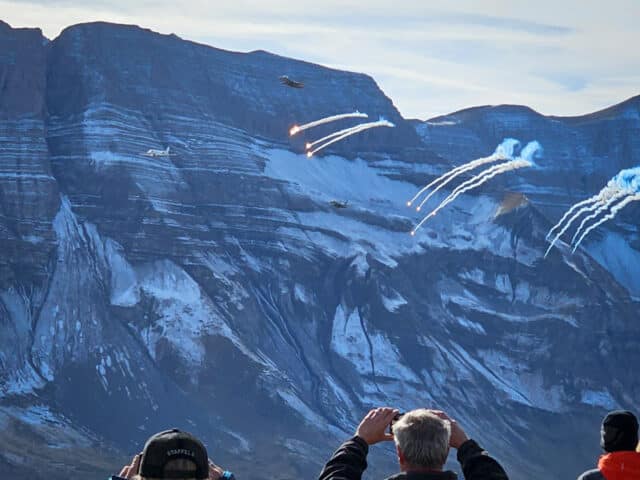
It was fascinating to see the actual intercepts although I have to admit that it did very little to reduce my anxiety: mostly I still think “please, god, don’t let that ever be me.”
A grey single-engine plane, another Pilatus PC-7, I presume, appeared above us from the west and with a bit of squinting it became clear that men were falling out of it — more men than it seemed should fit in the small plane.
The paratroopers floated through the sky, two of them unfurling flags as they circled above us. They glided directly over the crowd to descend into the valley below, somehow steering their parachutes to land back at Meiringen.
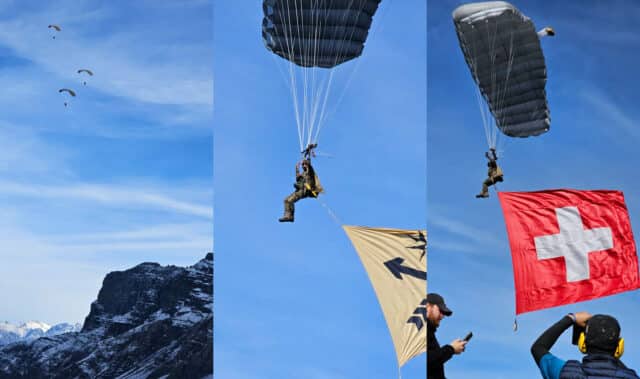
A trio of aircraft flew past: the single-engine Pilatus PC-7, the turboprop Pilatus PC-21 and the jet fighter F/A-18C Hornet. Loudspeaker Man told us that Axalp was the only opportunity to see these three aircraft in formation.
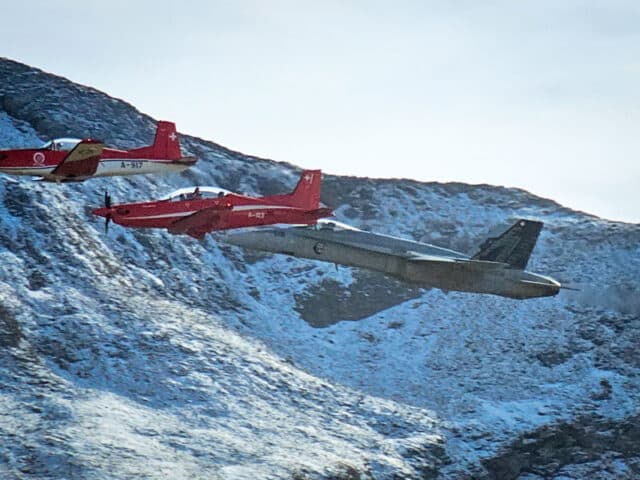
The truth was, I’d never before seen a Pilatus PC-21 and found myself most intrigued by its position between the PC-7 and the F-18. Described by the Australian Royal Air Force as the most advanced pilot training aircraft, the Swiss-built turboprop has a cockpit designed to match the F-18, making for a training opportunity by bringing propeller planes into the jet age.
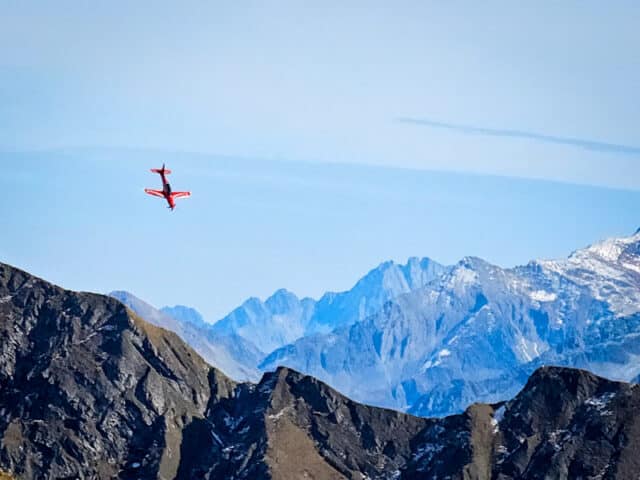
As a red PC-21 flew past at eye height and showed us its belly as if begging for scritches, I knew that I could love it even more than a fighter jet, if given half a chance.
“And now,” said the Loudspeaker Man, before his voice was cut off by the roar of fighter jets too impatient to await their introduction.
This was the Swiss Hornet Display team with a programme specifically designed for the Axalp arena. They appeared and disappeared from all directions as we stood on the slope spinning to keep them in sight. They disappeared upside down over the ridge and then appeared again from behind us, as if in the greatest game of peek-a-boo ever played.
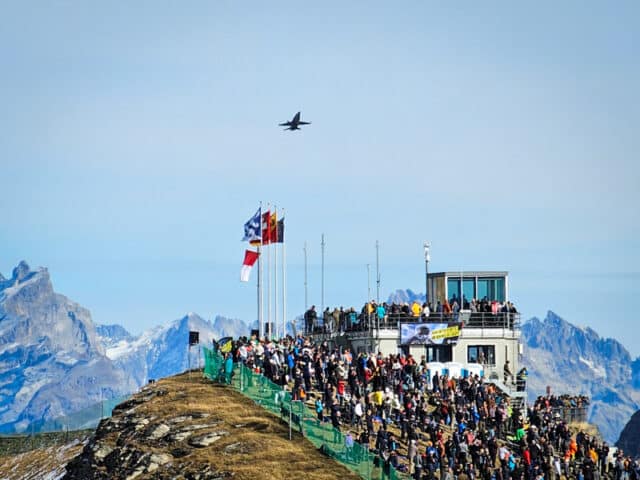
Another Super Puma rumbled onto the scene and hovered near the target area, at which point it came clear that soldiers who were safely inside the helicopter were escaping and landing on the scrubby grass below.
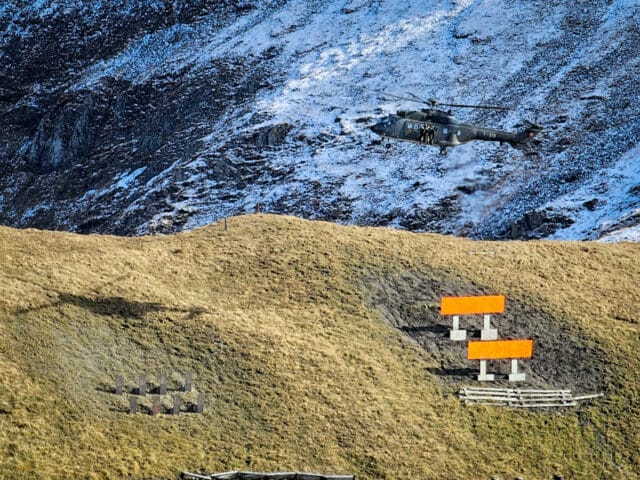
This was a demonstration of a special forces operation, in which the team were dropped into enemy territory to secure an area. The Super Puma quickly departed as Loudspeaker Man explained that its goal was to get in and out as quickly as possible as the most vulnerable part of this operation. Meanwhile, the attacking special forces had dug in and clouds of smoke appeared as they fired on their target. The target remained in place. This was not, Loudspeaker Man was quick to assure us, because they had bad aim. Putting the targets into place on the side of the mountain was inconvenient and expensive, so the team had to be very precise in order not to destroy it as a part of the exercise.
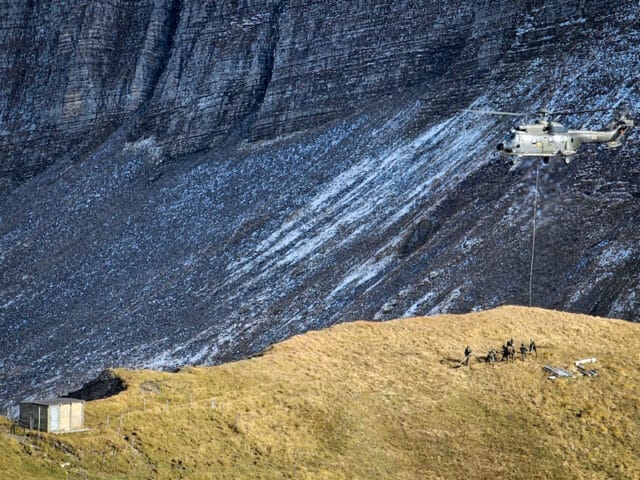
Once they had achieved their goal, the special forces team checked on each other to ensure that everyone was ready for evacuation. The Super Puma quickly came in and hovered above them, releasing a thick cable. One at a time, the team members climbed up the rope and attached themselves so that they could be evacuated at speed, dangling from the helicopter.

“Sometimes we watch these demonstrations and wonder if we could do that job,” said Loudspeaker Man. “And when I watch this one, I know that I could not, without a doubt, could not do this.” The audience nodded in agreement as the helicopter flew back to Meiringen with men twisting and turning on the cable.

The military registrations, or more correctly serial numbers, were plainly visible as each aircraft did a fly-past along the shooting range. The Swiss Air Force has a very straight-forward system for the initial letter:
A Ausbildung = Trainer
C Cible = Target
J Jäger = Fighter
T Transport
U Umschulung = “Advanced trainer”
Then the loudspeakers began to play everyone’s famous Top Gun anthem, Kenny Loggins Danger Zone, and I knew it was time for the Northrop F-5E Tiger II fighters of the Patrouille Suisse.
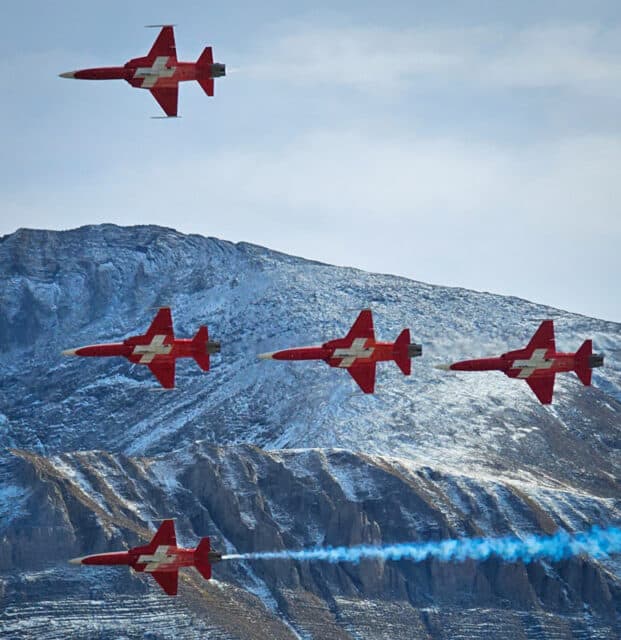
As the fighters appeared in a row, an expert on the display team took over the map and introduced us to the pilots. I’m embarrassed to say that I only remember “Tiger Sexi” as the most incongruous call sign I’d ever heard outside of Hollywood. You cannot apply to join the Patrouille Suisse display team, you must be invited. The Patrouille Suisse pilots fly visually, with “no technical aids available”, said our announcer, although I’m not sure that the cockpits are missing their artificial horizons and altimeters. The display team leader charts the course and the remaining pilots orient themselves in relation to the aircraft in front.
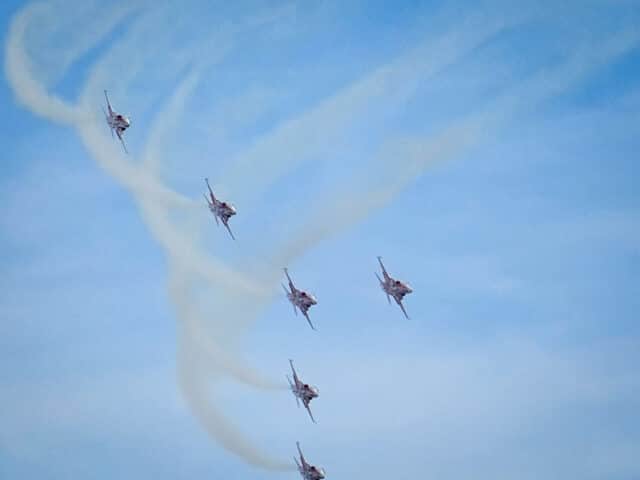
They are based in Emmen, which is where the next Swiss airshow will take place (Axalp is returning in 2025); 2024 is, probably not coincidentally, also the team’s 60th anniversary, so this will be sure to be an amazing spectacle. It’s hard to imagine an improvement over the tight formations and aerobatic manoeuvres against the peaks of the mountains surrounding the natural amphitheatre.
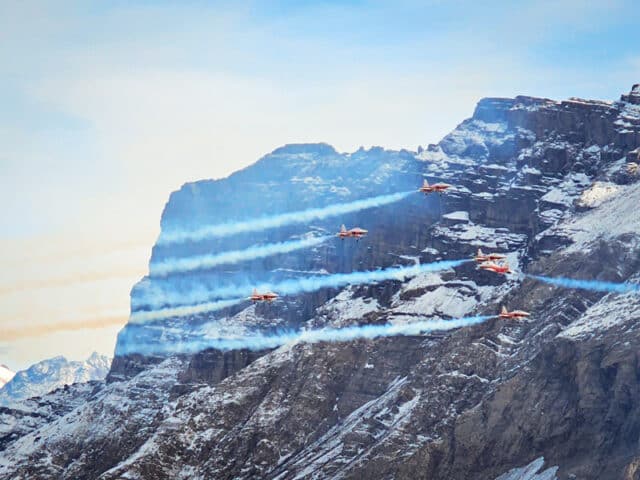
This traditional airshow display was clearly a crowd favourite and formed a fitting grand finale to the 90 minutes of amazing flight demonstrations that we had witnessed. After raucous applause, the thump-thump-thump of a herd of helicopters filled the air as they flew over the ridge for a fly-by before returning to KP to ferry the VIPs to the lake.
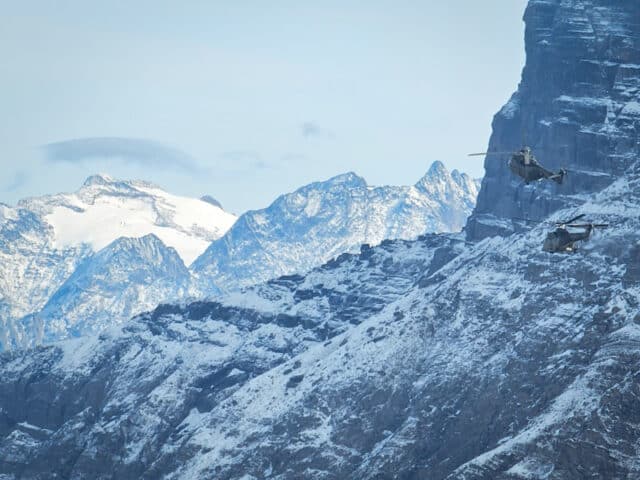
Of course, every airshow is an experience and every airshow is unique. Yet, the Axalp Fliegerschiessen felt like a once-in-a-lifetime opportunity. This is no doubt influenced by the effort required. It had taken me two buses, two flights and two trains to get to Brienz the night before and that morning I was up at 5 to catch the early shuttle bus up the mountain.
The second day, too tired and sore to fight my way up the mountain. I took the shuttle bus to Axalp and waved at every low-flying helicopter on their way to KP, in hopes that one might like to pick me up. When that plan failed, I opted for a gentle walk to Chruttmettli, a collection of wooden huts and hilly pastures on the lake side of the ridge. Here, I could comfortably look up to where I’d been standing the day before and was granted an intriguing view of the aircraft flying into and out of the Ebenflüh shooting range.
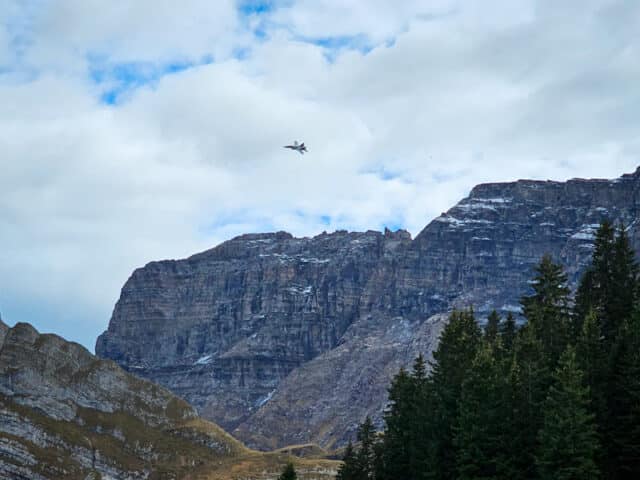
This in no way compared to the official spectator areas but I was fascinated to experience the same show again from backstage. The F-18s repeatedly appeared from over the ridge still inverted, twisting straight and level directly over my head. I could see the formations form and split up, preparing for sneaky passes along the spectator area. The paratroopers descending back to Meiringen were close enough to make eye contact as they floated down the valley. When the Patrouille Suisse circled overhead at the end of the show, I hummed Top Gun for them. I felt like I’d had an unexpected personal experience to round off the event.
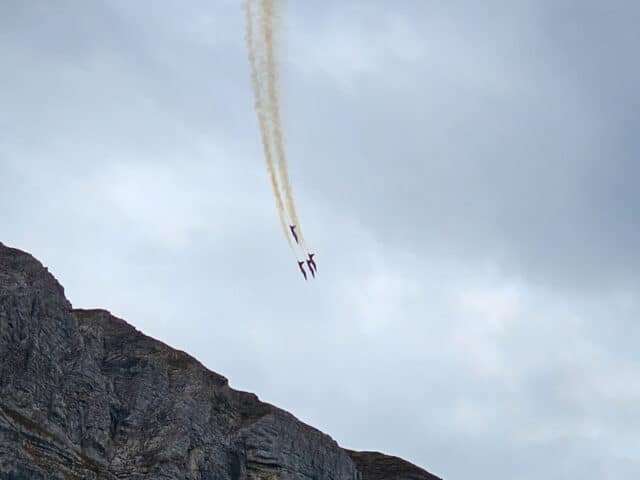
Of course, the breathtaking landscape of the Bernese Alps cannot be overstated. I cannot think of a more beautiful backdrop for an air show aerial demonstration.
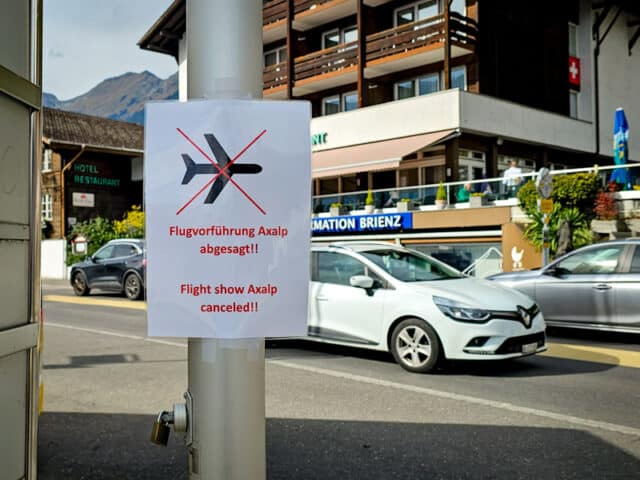
We were all very disappointed to discover that the third day of the event had to be cancelled after forecasts of the Föhn winds but as a consolation prize, I rode a steam train to the top of Rothorn mountain where I watched the F-18’s over the lake on their way out of Meiringen.
I recommend The Axalp Guide on Boschh for detailed information about the show and amazing photographs. It’s also worth searching YouTube or other video services with Axalp 2023 or #Axalp2023; you will find many excellent videos showing the displays (and possibly evidence that my memory of the sequence of events is faulty). None of this holds a candle to being there but it will give you a better perspective than my phone snaps!
If I am lucky enough to attend in 2025, I will avoid the chairlift completely, as well as the “short cut” steep slope leading up to Brau, and take the long way ’round. But, if any of those Super Puma pilots are reading, I’m still up for being flown to KP as a VIP. If that’s not an option, I’d happily accept a ride down the mountain with the friendly paratrooper who waved at me on day two. He looked like he wouldn’t mind.
